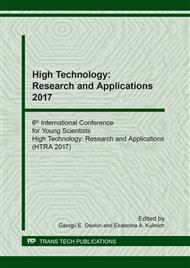[1]
O. Popov, H. Lieberwirth, T. Folgner, Quantitative Charakterisierung der Festgesteine zur Prognostizierung des Gesteinseinflusses auf relevante Produkteigenschaften und Systemkenngrößen. Teil 2, Ausgewählte Beispiele. AT Mineral Processing 10 (2014).
Google Scholar
[2]
C.W. Willson, N. Lu and W.J. Likos, Quantification of grain, pore and fluid microstructure of unsaturated sand from X-Ray CT images, Geotechnical Testing Journal, Vol. 35, No. 6 (2012).
DOI: 10.1520/gtj20120075
Google Scholar
[3]
C.L. Evans, et al. Quantifying mineral grain size distributions for process modelling using X-ray micro-tomography, Miner. Eng. (2015) http://dx.doi.org/10.1016/j.mineng.2015.03.026.
DOI: 10.1016/j.mineng.2015.03.026
Google Scholar
[4]
M. Ivanov, G Burlin, E. Kalmykov, Petrophisic research methods of core material (terrigenous deposits) Book 1 (2008) 112 p.
Google Scholar
[5]
A. Shtyrlyaeva, A.Zhuravlev, A. Gerasimova, Prospects and problems of computer microtomography using for core samples studies, Oil and gas geology: theory and practice, V.11, N.1 (2016) http://dx.doi.org/10.17353/2070-5379/8_2016.
DOI: 10.17353/2070-5379/8_2016
Google Scholar
[6]
L. Vaisberg, , E. Kameneva, Study of physical and mechanical properties of building rock affecting their quality dezintegration and final commercial products, Plaksinskie chtenija, (2013) 7-12.
Google Scholar
[7]
S.T. Ho, D.W. Hutmacher, A comparison of micro-CT with other techniques used in the characterization of scaffolds, Biomaterials 27 (2006) 1362–1376.
DOI: 10.1016/j.biomaterials.2005.08.035
Google Scholar
[8]
E. Broch, J. A Franklin., The Point-Load Strength Test. Int. J. Rock Mech. Min. Sci. & Geomech. Abstr., Vol. 9 (1972) 669–697.
Google Scholar
[9]
N.Brook, The Equivalent core diameter method of size and shape correction in point load testing, Int. J. Rock Mech. Min. Sci. & Geomech. Abstr., Vol. 22 (1985) 61–70.
DOI: 10.1016/0148-9062(85)92328-9
Google Scholar
[10]
ISRM – International Society for Rock Mechanics: Suggested method for determining point load strength. Commission on Testing Method. Working Group on Revision of the Point Load Test Method. Int. J. Rock Mech. Min. Sci. & Geomech. Abstr., Vol. 22, No. 2 (1985).
DOI: 10.1016/0148-9062(85)92985-7
Google Scholar
[11]
K. Thuro, Drillability in conventional blast drilling. Geological-rock mechanical investigations on the basis of seven selected tunnel projects. Munich Geological Issues, Series B: Applied Geology, B 1, (1996) 1–145, I–XII.
Google Scholar
[12]
V. Raaz, Characterization of the rock strength by means of a modified point load test, Geol. Science, 30 Nr. 3 (2002) 213–226.
Google Scholar
[13]
N. Brook, The use of irregular specimens for rock strength tests. Int. J. Rock Mech. Min. Sci. & Geomech. Abstr., Vol. 14 (1977) 193–202.
DOI: 10.1016/0148-9062(77)90948-2
Google Scholar
[14]
K. T. Chau, R. H. C. Wong,: Unaxial compressive strength and point load strength of rocks. Int. J. Rock Mech. Min. Sci. & Geomech. Abstr., Vol. 33 (1996) 183–188.
DOI: 10.1016/0148-9062(95)00056-9
Google Scholar


